100 Film Favorites – #59: Mickey’s Christmas Carol
(Wolfgang Reitherman, 1983)
Okay, so technically this is a short film, and not a feature. But since I’ve already included made-for-TV movies and even half-hour television specials, I hope you’ll excuse me playing fast and loose with the selection criteria once again.
Those of you who have been following along since the olden days of the first Christmas Classics Countdown back in 2011 may remember that I featured Mickey’s Christmas Carol as one of the entries. In this post I’ll mostly be re-hashing what I said then, but at least it’ll save you some scrolling.
The short, which originally debuted paired with a re-release of The Rescuers,” is a retelling of Dickens’ A Christmas Carol with Disney characters playing the various roles. As such, I shouldn’t really need to summarize the story, but here goes: Scrooge (played by the crotchety duck who bears his name) is a mean old miser who abuses his employee, Bob Cratchit (Mickey Mouse). One Christmas Eve, Scrooge is visited by the ghost of his former business partner (Goofy), and three spirits who show him the events of Christmases Past (Jiminy Cricket), Present (Willie the Giant from “Mickey and the Beanstalk”), and Future (Pete). Shaken by what he has seen, Scrooge promises to change his ways, and becomes “as good a man as any the good old city knew.”
This was the first version of the oft-repeated Yuletide tale that I ever saw, which probably has a lot to do with why this particular adaptation has stuck with me. I’m a big Christmas Carol fan, and have probably watched more than a dozen versions multiple times, but this still stands among the better ones. While some productions may stick closer to the book (much is omitted to keep the film under a half hour and reasonably child-friendly), Mickey’s Christmas Carol concisely captures the gist of the story while ably maintaining its Christmasy tone. What’s more, as mentioned in the original 2011 post, Scrooge McDuck may make the single best Scrooge of any I’ve seen. For one, he actually has a British accent (well, Scottish, but still). Secondly, voice actor Alan Young gives a very emotional, expressive performance, and he’s convincing both as “mean Scrooge” and “changed Scrooge” – a feat which some other Scrooge-portrayers have struggled with.
 I could spend multiple posts comparing and contrasting the relative merits of various “A Christmas Carol” adaptations, but I’ll try to restrain myself. Since the plot-summary of this film was so short, I’ll supplement it with a mini-countdown of some of my favorite versions of the story:
I could spend multiple posts comparing and contrasting the relative merits of various “A Christmas Carol” adaptations, but I’ll try to restrain myself. Since the plot-summary of this film was so short, I’ll supplement it with a mini-countdown of some of my favorite versions of the story:
6. The version with Patrick Stewart as Scrooge: While the lead actor doesn’t come across as particularly Scrooge-like, this film is remarkable for incorporating virtually every detail from the novel, including scenes which are almost universally excluded from adaptations (such as one in which Scrooge flies out across the ocean with the Ghost of Christmas Present to visit a ship at sea, where sailors are merrily singing carols, even far from home).
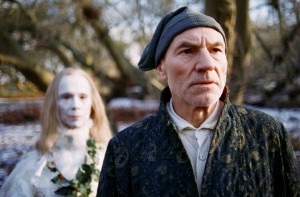 5. The Muppet Christmas Carol: Michael Caine – an honest-to-goodness British Scrooge! The first Muppet feature following Jim Henson’s death, this film shows that the remaining Muppeteers were still firing on all cylinders creatively.
5. The Muppet Christmas Carol: Michael Caine – an honest-to-goodness British Scrooge! The first Muppet feature following Jim Henson’s death, this film shows that the remaining Muppeteers were still firing on all cylinders creatively.
 4. Mr. Magoo’s Christmas Carol: The bumbling, nearly blind cartoon fogey stars as Scrooge, in an adaptation with lots of memorable musical numbers.
4. Mr. Magoo’s Christmas Carol: The bumbling, nearly blind cartoon fogey stars as Scrooge, in an adaptation with lots of memorable musical numbers.
 3. The version with George C. Scott as Scrooge: Well, the star’s not British, but the production values are lavish. This is my favorite feature-length adaptation of the story to date.
3. The version with George C. Scott as Scrooge: Well, the star’s not British, but the production values are lavish. This is my favorite feature-length adaptation of the story to date.
 2. Mickey’s Christmas Carol: This is the version you’re reading about now. You probably know that.
2. Mickey’s Christmas Carol: This is the version you’re reading about now. You probably know that.
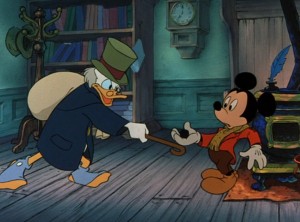 And my favorite adaptation of all doesn’t make this Countdown, because it’s not a film. That honor goes to the Virginia Theater Machine‘s annual Christmas Carol” production, starring Master Thespian Ed Whitacre. This roughly 20-minute event occurs annually in Merchants’ Square in Colonial Williamsburg. Performed out of the back of a small trailer modified into a miniature stage, the show began as Whitacre’s (facetious) attempt to stage an entire one-man production of the Christmas Carol story in less than fifteen minutes. Thus, the “Master Thespian” played all the roles, using various forms of puppetry to depict the different ghosts. But what really puts this adaptation over the top is the fact that it changes every year. The show’s first performance ended with “Scrooge” running into assorted obstacles and failing to complete the story within his self-imposed 15 minute time limit. At this point, Bob, the “stage manager” whom Whitacre had earlier mistreated, emerges from the back of the trailer to cheer him up. Convinced that “the show must go on,” the Master Thespian rallies and delivers a rousing finish. At the end, he mirrors the tale by offering Bob “a raise,” allowing him a role in the play itself.
And my favorite adaptation of all doesn’t make this Countdown, because it’s not a film. That honor goes to the Virginia Theater Machine‘s annual Christmas Carol” production, starring Master Thespian Ed Whitacre. This roughly 20-minute event occurs annually in Merchants’ Square in Colonial Williamsburg. Performed out of the back of a small trailer modified into a miniature stage, the show began as Whitacre’s (facetious) attempt to stage an entire one-man production of the Christmas Carol story in less than fifteen minutes. Thus, the “Master Thespian” played all the roles, using various forms of puppetry to depict the different ghosts. But what really puts this adaptation over the top is the fact that it changes every year. The show’s first performance ended with “Scrooge” running into assorted obstacles and failing to complete the story within his self-imposed 15 minute time limit. At this point, Bob, the “stage manager” whom Whitacre had earlier mistreated, emerges from the back of the trailer to cheer him up. Convinced that “the show must go on,” the Master Thespian rallies and delivers a rousing finish. At the end, he mirrors the tale by offering Bob “a raise,” allowing him a role in the play itself.
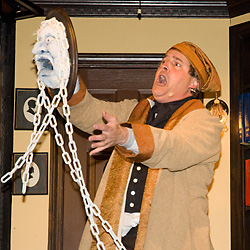 When I returned the next December, I expected the story to play out the same…but was surprised to find that the show, while still framed as a mile-a-minute, minimalist adaptation of the Christmas Carol story, was also a sequel to the previous year’s production. It was now a two-man show, though “Bob” had only silent roles, at the end being “promoted” to a speaking part.
When I returned the next December, I expected the story to play out the same…but was surprised to find that the show, while still framed as a mile-a-minute, minimalist adaptation of the Christmas Carol story, was also a sequel to the previous year’s production. It was now a two-man show, though “Bob” had only silent roles, at the end being “promoted” to a speaking part.
Year after year, the story grew, with a whole troupe of characters developing around the same initial framework of one man attempting a rapid-fire Christmas Carol. Year 3, Ed and Bob took an intern, who assumed Bob’s abused role from the earlier productions. Year 4, we met the Master Thespian’s old teacher. While initially unshakingly devoted to her, Ed eventually protests to her disrespectful treatment of Bob and stands up to her. Impressed, the old teacher promotes Whitacre to “Grand Master Thespian.”
Perhaps even more remarkable, the two-man crew isn’t content to re-use the same puppets year after year. Instead, innovative new puppets are used for the various Ghost characters almost every year, incorporating many different styles of puppetry.
 The show was first staged my freshman year at William and Mary (Christmas 2008), and I’ve been back every year since. I returned this past December for Year 5, in which Ed and Bob crowd-sourced the script, cobbling together bits of dialogue suggested by subscribers to their mailing list. And I guess I’ll just have to keep going back, or risk missing a key development in the continuing saga of Master Thespian’s attempts to re-enact Dickens at breakneck speed.
The show was first staged my freshman year at William and Mary (Christmas 2008), and I’ve been back every year since. I returned this past December for Year 5, in which Ed and Bob crowd-sourced the script, cobbling together bits of dialogue suggested by subscribers to their mailing list. And I guess I’ll just have to keep going back, or risk missing a key development in the continuing saga of Master Thespian’s attempts to re-enact Dickens at breakneck speed.
Okay, this post has admittedly become more about the Virginia Theatre Machine than about Mickey’s Christmas Carol, but I’ll try to wrap up with some more relevant odds and ends.
-The film marks a lot of firsts for Disney. It was the first theatrically produced Mickey Mouse short in three decades, and the first to feature Wayne Allwine as the voice of Mickey (replacing the original voice actor, Walt Disney himself, who had died in 1966). The film was also one of the first projects on which future Pixar luminary John Lasseter worked as a young animator.
Conversely, the film marks some notable “lasts” as well. It was the last project for Clarence Nash, the original voice of Donald Duck. It was also one of Disney’s last films to include complete opening credits. This is a topic I could also go on at length about, but I suppose I’ll have a chance to discuss it again in a later post. Suffice it to say that I’m a sucker for compelling opening credits sequences. It was once the norm in Hollywood for films to feature opening credits which included a complete list of people who worked on the film (information which we now think of as typical of ending credits). In fact, the practice of using full opening credits and minimal ending credits was the standard until 1977, when George Lucas opted to not feature opening credits at all in Star Wars. Lucas was fined $250,000 by the Directors’ Guild of America for this perceived “violation,” but the trend quickly caught on. By 1983, the old model for credits was already becoming rare, subsumed by the new “lots of ending, little opening” standard. While this new style feels normal now, it’s kind of disheartening to think that while audiences were once expected to sit through the sequence in which the filmmakers’ respective contributions are acknowledged, this information is now presented while film-goers are supposed to be leaving the theater. Oh well. Times change.
As a final note, Mickey’s Christmas Carol was one of the first films to feature characters from many different Disney films living and interacting in the same world, years (and even decades) before projects such as Who Framed Roger Rabbit?, House of Mouse, and the Kingdom Hearts franchise. While the major roles in Mickey’s Christmas Carol are primarily portrayed by characters from the typical “Mickey Mouse universe” (Mickey, Minnie, Donald, Goofy, etc.), the film features many characters originating from further afield within the Disney canon. Several of the animal characters from the 1973 Robin Hood make appearances, and the characters from the 1949 Wind in the Willows adaptation play more significant roles (with Mole and Rat as the alms-collectors, the Weasels as grave-diggers, and Mr. Toad as Fezziwig). Perhaps the most obscure cameo is by the Secretary Bird from 1971’s Bedknobs and Broomsticks, seen dancing at Fezziwig’s party with Lady Kluck from Robin Hood. Mickey’s Christmas Carol is clearly a loving homage to Disney history, while simultaneously ushering in a new generation of talented artists, many of whom would spearhead the approaching “Disney Renaissance.”
—
Brian Terrill is the host of television show Count Gauntly’s Horrors from the Public Domain. You can keep up with Brian’s 100 Film Favorites countdown here.


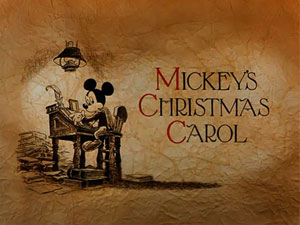
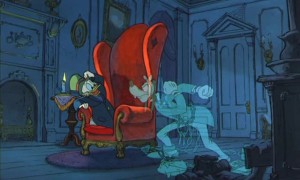




Actually, ”Mickey’s Christmas Carol” was produced and directed by Burny Mattinson, not Wolfgang Reitherman (as Reitherman retired from Disney in 1981).